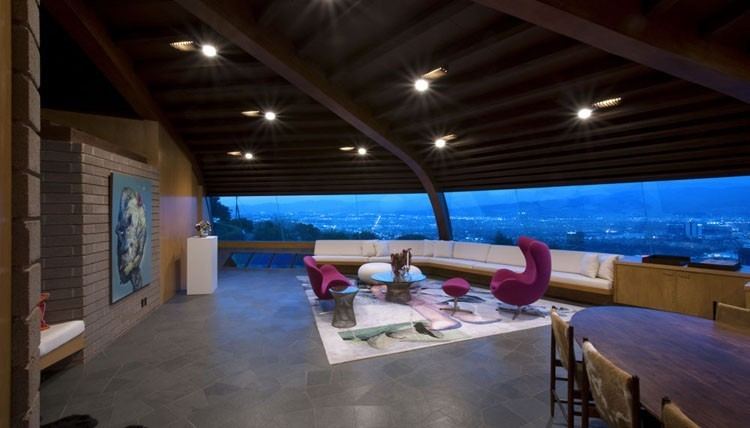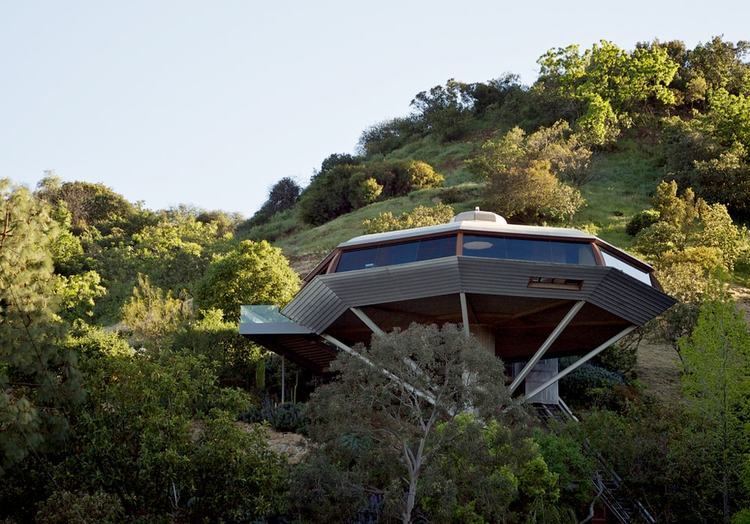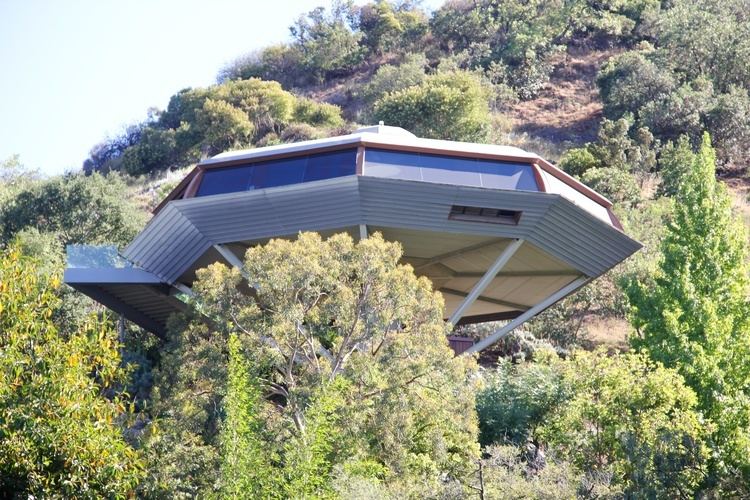Designated 2004 Opened 1960 Architectural style Mid-century modern | Reference no. 785 Owner Benedikt Tauschen | |
 | ||
Location 7776 Torreyson DriveLos Angeles, California Similar Elrod House, Sheats Goldstein Residence, Garcia House, Case Study House #22, Ennis House | ||
Exploring jon lautner s chemosphere oddity odysseys
The Chemosphere is a modernist house in Los Angeles, California, designed by John Lautner in 1960. The building, which the Encyclopædia Britannica once called "the most modern home built in the world", is admired both for the ingenuity of its solution to the problem of the site and for its unique octagonal design.
Contents
- Exploring jon lautner s chemosphere oddity odysseys
- John lautner the chemosphere
- Design
- History
- Recognition
- In popular culture
- References
John lautner the chemosphere
Design

The building stands on the San Fernando Valley side of the Hollywood Hills, just off Mulholland Drive. It is a one-story octagon with around 2200 square feet (200 m2) of living space. Most distinctively, the house is perched atop a 5-foot-wide (1.5 m) concrete pole nearly 30 ft (9 m) high. This innovative design was Lautner's solution to a site that, with a slope of 45 degrees, was thought to be practically unbuildable. Because of a concrete pedestal, almost 20 feet (6 m) in diameter, buried under the earth and supporting the post, the house has survived earthquakes and heavy rains. The house is reached by a funicular. Chemosphere is bisected by a central, exposed brick wall with a fireplace, abutted by subdued seating, in the middle.
History
The lot had been given to a young aerospace engineer by his father-in-law; despite his own limited means, the engineer, Leonard Malin, was determined to live there. Malin had US$30,000 to spare. The cost to build Chemosphere, US$140,000, was subsidized partly by barter with two sponsoring companies, the Southern California Gas Company and the Chem Seal Corporation. Chem Seal provided the experimental coatings and resins to put the house together and inspired the name Chemosphere. (Lautner originally wanted to call the house Chapiteau.) In the end Malin paid US$80,000 in cash. The Malins and their four children lived there until rising costs and the demise of the aerospace industry forced them to sell in 1972.

In 1976, the house's second owner, Dr. Richard Kuhn, was stabbed to death at his home in a robbery by two men, who were subsequently convicted and sentenced to life in prison.

By 1997, the interior had become run down; for over 10 years it had been rented out and used for parties and as a result the interior finishes had undergone major and anachronistic alteration. Because of its unique design it proved to be a difficult sell and had sat on the market for most of its time as a rental property.

Since 1998, it has been the Los Angeles home of Benedikt Taschen, of the German publishing house Taschen, who has had the home restored; the only current issue with the home is the relatively high cost of maintenance. The recent restoration, by Escher GuneWardena Architecture, won an award from the Los Angeles Conservancy. Preservation architect Frank Escher wrote the first book on Lautner a few years after moving to Los Angeles in 1988, and oversees the John Lautner Archives. During restoration the architects added details that were unavailable 40 years before, as the technology simply did not exist. The gas company tile was replaced by random-cut slate, which could not be cut thin enough in 1960, despite Lautner's desire for such a finish. The architects also replaced the original thick framed windows with frameless glass. The owners commissioned a pastiche rug by German painter Albert Oehlen and a hanging lamp of bent plexiglas strips by Jorge Pardo, a Los Angeles artist.
The Taschen family planned to commission Dutch architect Rem Koolhaas to build a large new guesthouse at the base of Chemosphere on the site once owned by Leonard Malin's in-laws. The new house was intended to hold an art collection and library and to provide rooms enough for the four children the Taschens have between them. The plans were later cancelled due to fears the annex would visually compete with the main house. During the first few years the Taschens lived there, the house became locally famous for their parties, where photographer William Claxton and his model wife Peggy Moffitt would carouse with porn stars, jazz musicians and director Billy Wilder.
Recognition
The Chemosphere was declared a Los Angeles Historic-Cultural Monument in 2004. It was also included in a list of all-time top 10 houses in Los Angeles in a Los Angeles Times survey of experts in December 2008.
The house forms part of a retrospective of Lautner's work which was shown at the Hammer Museum in Los Angeles between August and October 2008.
In popular culture
The building was first used in a dramatic film as a futuristic residence in "The Duplicate Man", a 1964 episode of the ABC TV-program The Outer Limits, based on a science fiction story by American author Clifford D. Simak. Exterior scenes for the television episode were shot on location; a detailed sound stage set of the house's interior was built.
It was also used in the 1984 film Body Double, directed by Brian De Palma.
A set for a scene in Charlie's Angels was inspired directly by the Chemosphere.
It appears in the end credits of the 2015 Disney fantasy film, "Tomorrowland," starring George Clooney.
In the animated show The Simpsons the fictional TV star Troy McClure lives in a house with a very similar look.
